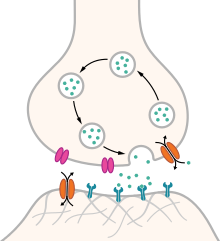Source: NIH, National Cancer Institute through Wikimedia Commons
Neurons are the building blocks of our brain and the whole neuron system. Until 1887, our brain and the spinal cord were composed of a continuous single network. Santiago Cajal, in 1887, using a stain developed by Camillo Golgi, showed separate cells connected through spaces. However, Camilio Golgi disputed the claim. Wilhelm von Waldeyer-Hartz named these cells “neurons”.
Previously, we entered the neuron forest. Neurons are like trees in a forest. They are elegant, superior, and live wonderful lives. On average, our brain owns about 100 billion neurons.
What are neurons?
A neuron is a specialized cell, only found in the brain and its connected nervous system. The following illustration describes parts of a typical neuron; however, we can find highly specialized neurons in different brain parts.
Cell body
Like any other cell, a neuron owns a cell body – the main control centre. It contains a nucleus and other essential structures to maintain life such as mitochondria to produce energy and other apparatus that transport substances within the fluid inside the cell.
Dendrites
You can find dendrites as tree-like structures much closer to the cell body. These branches receive messages from other neurons and bring those messages toward the cell body. In some places, such as Cerebellum, one neuron can have about 200,000 branches.
Axon
This tube-like structure propagates received signals towards the axon terminals to transmit to other neurons or its endpoint for action. Axons’ length can vary from millimetres to a meter. For example, axons propagating information from the spinal cord to the toes should be lengthy. Sometimes, one axon owns many terminals. As a result, these axons can send messages to many neurons at the same time. On the other hand, some neurons such as the cells in the retina where information from the eyes is processed do not have axons.
Myelin sheath
The axons that transmit information for action (motor neurons) have a thick covering, called “myelin sheaths”. They act like an insulator in a wire to send information faster.
Myelin sheaths are not parts of a neuron; these are produced by its supportive cells, called, “Glial cells”.
As you can see, these sheaths are interrupted from place to place to recharge the electric signals. Such places are named, “nodes of Ranvier”, because Rnavier first described those.
How neurons transmit information
The following GIF explains vividly how this happens through an axon. As you can see when the axon is at rest, the inside of the cell membrane is negatively charged; exactly – 70 millivolts than the outside. It is maintained using a pump. It is costly because it pumps out three sodium ions while pumping in two potassium ions. This pump uses energy using one ATP molecule at each time.

How neurons communicate with each other: The synapse
Once a message reaches the axon’s terminal, it has to travel through a small pond to pass it on to the next neuron. It is no longer an electric transmission. Rather, it is a chemical transmission.
The following diagram drawn by Thomas (the link above) illustrates this pond and the activities that occur when an electrical message reaches the cup-shaped terminal. The other end is the beginning of a dendrite.
The lower end which faces the axon terminal is the dendritic end. The electrical impulse stimulates chemical-filled vesicles and they release their chemicals into the cleft. Finally, the receptors of the dendrites capture those chemicals; they trigger electrical impulses in the dendrites and travel until they reach the neurons’ axon terminals.

CC-BY-SA-4.0
author Thomas Splettstoesser
So, the neuron – the messenger – does not go anywhere; only the message – after translating the message’s electrical form into a chemical form – travels from one neuron to another. That is why the whole neuron system consists of about 100 billion neurons.
Different message types
Although the mechanism is the same, neurons transmit different message types; either to carry on certain tasks such as moving a hand or to recognize certain sensations such as smell, touch, pain, etc. The motor neurons send messages either to do or not to do movements. The sensory neurons bring messages of touch, pain, hearing, seeing, etc.


